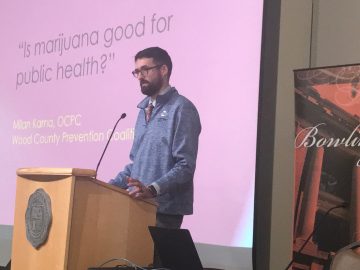By DAVID DUPONT
BG Independent News
Cannabis offers a promise for addressing forms a dementia, a researcher said recently at a public health symposium at Bowling Green State University.
Dr. Norbert Kaminski, a researcher from Michigan State University, has studied possible use of cannabinoids in treating the dementia that arises in HV/AIDS patients, and that may extend to other diseases that affect the brain.

Milan Karna and Kyle Clark, from the Wood County Prevention Coalition, issued a strong warning that the use of marijuana itself was a danger to the minds and bodies of local youth.
Both presentations were part the public health symposium on the topic: “Is Marijuana Good for Public Health?”
That question almost caused Kaminski to decline the invitation to speak. He’s a researcher, and is not interested in issuing judgments. Kaminski was the Ned Baker Keynote Speaker.
“I don’t care what therapeutic agent you have, it will have its beneficial effects as well as detrimental effects. I don’t know any therapeutic agent that doesn’t have those properties,” he said.
“As a scientist I don’t think about cannabinoids as recreational. I think that they may be able to help people who have various illnesses.”
THC has anti-inflammatory properties. Researchers found that this helped to fight the inflammation in the brain of those suffering from AIDS hat caused dementia.
AIDS patients first took cannabis medically as an appetite stimulant.
The inflammation in the brains of AIDS patients, Kaminski said, is similar to that found in those suffering from Parkinson’s, Alzheimers, and other neurodegenerative diseases.
“There’s a potential that some of these cannabinoid compounds that we’re studying may help individuals with those conditions as well,” Kaminski said. “It’s not a cure. It would just slow the progression of those diseases.”
Karna said that tobacco and alcohol companies once used health claims to market their products.
Cannabis has been cited as a treatment for more than 20 conditions, according to Kaminski. Medicinal properties of hemp were first noticed in the first century AD in China.
Karna showed a documentary video where someone went online and consulted with a doctor who gave him a prescription for medical marijuana and the drug was delivered to his door within an hour.
That ease of access is troubling, said Clark.
Increased access leads to increased use by youth. He compared it to the opioid epidemic that started with the abuse of legal pain killers. The same pharmaceutical companies involved in that crisis are now looking at marijuana.
Ohio has taken a more conservative approach in legalizing medical marijuana, Clark said. It doesn’t allow smoking or cannabis in the form of candy.
Still an incident in Cleveland earlier this year shows the danger. A student brought gummy bears suspected of being laced with marijuana to school and shared them with fellow students, ages 5 to 9, who were sickened.
Karna said that, though, touted as a medical treatment, marijuana does not go through the same rigorous testing by the Federal Drug Administration that other drugs do.
Levels of THC, the hallucinogenic element, varies greatly, and producers are working to increase the potency of marijuana, he said.
Using statistics from the group Smart Approaches to Marijuana, Clark cited, irreversible drops in IQ and a rise in addiction rates among those who start consuming marijuana when they are young.
“I’ve always been under the assumption,” Clark said, “when we make policies and laws, we always make them in terms of adults and only after the fact do we find concerns with youth … because we realize it’s harmful. … We need to look at the potential side effects of those laws and what it can do to the youth of our country, nation, state, county. They don’t have a say in the matter. They’re relying on us to look out for their safety and protection.”
The drug remains a highly regulated schedule 1 substance because federal officials still believe it is dangerous, Clark said.
Kaminski said in response to a question after his presentation that he feels that designation is unlikely to change any time soon.
Because of that universities do not allow studies using plant material. He does have very small amounts of cannabinoid in other forms in the lab. And to maintain that amount requires a lot of paperwork and visits by Drug Enforcement agents who can show up at any time “to see where I keep these compounds and how we keep track of what we have.”
Instead his studies volunteers who are using cannabis, he said. But “we don’t provide them cannabis.”





